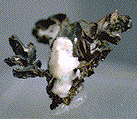
- Chemistry: Cr, elemental chromium
- Class: Elements
- Subclass: Native Metals
- Uses: Many applications for the metal chromium.
Specimens
Chromium rarely occurs naturally in its elemental form and has never been used as an ore of itself.
However some native uncombined chromium has been discovered and therefore chromium is recognized as a mineral.
The first specimens are attributed to the type locality in Sichuan, China, but the Udachnaya (Lucky) Mine in Russia produces more reliable examples.
The Udachnaya is a Kimberlite pipe rich in
diamonds.
The reducing environment of the kimberlite helped to produce the elemental chromium and diamond.
Chromium is related to two chromium and iron alloys:
As an element, chromium is very useful. Its name comes from the Greek word for color, chroma. This is a good name for chromium, for it is one of the strongest coloring agents known. Numerous minerals owe their colors to chromium either from chromium being an important part of their chemistry or just as a trace. Chromium gives ruby its red and emerald its green. A little chromium goes a long way! The small list of chromium colored minerals in the table below demonstrates this well.
in the formula: |
as a trace: |
|
Industrially, chromium is used for a host of purposes. It is considered a strategic metal and is used in alloys for hardening and corrosion resistance. Its various compounds are used for a variety of colors in paints and glass. Some chromium chemicals are also used as oxidizers and for many other uses. Most chromium is extracted from the ore mineral chromite and some from crocoite.
PHYSICAL CHARACTERISTICS:
- Color is white.
- Luster is metallic.
- Transparency: Specimens are opaque.
- Crystal System is isometric; 4/m bar 3 2/m.
- Crystal Habits are limited to granular specks and labratory grown specimens.
- Hardness is 4
- Specific Gravity is 7.21 (heavy for a metallic mineral).
- Associated Minerals include diamond, spinel, copper and iron.
- Notable Occurrences include the type locality in Sichuan, China as well as the Udachnaya (Lucky) pipe, Yakutia, Russia.
- Best Field Indicators are color, locality, hardness and density.







